Strumaria
Strumaria Jacq.
Family: Amaryllidaceae
Common names: Cape snowflake (Eng.); tolbol (Afr.)
Introduction
Species of Strumaria enrich South Africa's bulbous flora with an array of rare and endemic plants that flower in autumn, when little else is in bloom.

Description
Description
Strumaria is a moderately diverse group of small, bulbous plants. Covered with felt-like tunics, the bulbs produce long, extensible, spiralled threads when torn, a feature that identifies all members of the tribe Amaryllideae to which it belongs. The growth cycle is much like that of other deciduous members of the Amaryllidaceae from the winter rainfall region of South Africa. New leaves emerge soon after the first rains fall in winter and they die in late spring, long before the flowers appear in autumn.
The genus has two patterns of leaf growth. Most species have two or rarely three leaves arranged opposite each other and these are often fringed or clothed with hairs. They are arched or pressed to the ground and vary from strap- to oval-shaped. In contrast, a few species have up to six smooth, strap-shaped leaves that grow in a spreading, somewhat erect fan. Strumaria truncata is unusual in having a prominent, inflated, liver-coloured sheath which often precedes and protects the young foliage. Another particularly interesting species is S. bidentata which has sticky leaves that collect grains of wind-blown sand. This sand-bearing habit, known as psammophory, is characteristic of many plants from different families that thrive in sandy, windswept places.


The 2-30 flowers are held in a spreading or clustered, often pendulous, umbel-like head carried on a slender, naked stalk (scape). As they emerge from the ground, each flower cluster is enveloped by two membranous, pink bracts, but these soon part and wither to expose the pretty, star- to funnel-shaped flowers. Each flower is carried on a pedicel, the length of which varies considerably between species. Species in which the pedicels are long and rigid have heads like small, outspread umbrellas. In contrast, those with short, lax pedicels have small, loose heads. The flowers have six pink, white or pale lemon-yellow tepals that are often darkly striped on the outside and they produce copious amounts of nectar in three large droplets or wells at the base of the enlarged style. In several species the flowers are scented.
Three or six stamens are characteristically joined to the style which is swollen towards the base. In some species the stamens are joined only near the style's base, but in others the join extends half way up their length. A further unusual feature is that the filaments in some species are toothed. The swelling at the base of the style varies from disc-shaped to egg-shaped or even three-winged. Each of these forms helps to hold nectar in slightly different ways.
Thin-walled capsules, comprising three compartments, hold up to nine greenish red, egg-shaped seeds which vary from 2-5 mm in diameter.
Conservation Status
Status
Among the southern African Amaryllidaceae, Strumaria is second only to Cyrtanthus in terms of natural species' rarity. Twenty two species appear in the most recent Red Data lists of southern African plants. One species is Critically Endangered, two are Endangered, five are Vulnerable, one is Near Threatened, 12 are of Least Concern, and one is Rare. The greatest threat to most species is habitat loss, due mostly to diamond mining and increased demands for agricultural land, mainly for grapes, potatoes and rooibos tea.
Distribution and habitat
Distribution description
Strumaria is endemic to southern Africa. Most of the 28 species are found in the semi-arid winter rainfall region. Only two species extend into the summer rainfall region through the Great Karoo to the eastern Free State and Lesotho. The highest species concentrations are in the uplands of Namaqualand near Springbok and on the Bokkeveld Escarpment near Nieuwoudtville. Many rare Strumaria species are found near the periphery of the winter rainfall region in southern Namibia and the Richtersveld. They occupy rocky habitats and sand plains and many species are localized in small populations with highly restricted distribution ranges.
Derivation of name and historical aspects
History
Strumaria is derived from the Latin, struma, a cushion-shaped swelling, plus - aria which relates to 'possessing', a name that refers to the swollen base of the style.
Ecology
Ecology
The perfect symmetry and abundant supply of nectar make the flowers accessible and attractive to a wide range of insects-honey bees, various flies and butterflies. Observations on the breeding system show that Strumaria species are capable of self-fertilization as well as cross-fertilization. It is possible that as the climate deteriorated in the past, this flexible breeding biology may have enabled small populations to persist in increasingly harsh habitats, such as those found in southern Namibia and the Richtersveld in Northern Cape.
The seeds develop rapidly and remain succulent well into the early stages of germination. This unusual feature classifies them as recalcitrant, so called because they have no dormant state and cannot be stored. The seeds produced in umbrella-like fruiting heads are widely scattered after the dry heads break loose and roll away in the wind, whereas those formed in the laxly clustered heads merely drop to the ground fairly close to the parent plant.
The following species reflect some of the diversity within Strumaria in terms of plant size, flower colour, and habitat.
Uses
Use
Strumaria, unlike the closely related genera Boophone and Brunsvigia, has no known medicinal value and unlike Nerine, it has short-lived flowers, a feature which excludes the group from the cut flower industry.
Growing Strumaria
Grow
The plants are highly suited to pot culture. In cultivation they flower well and produce abundant seed. When grown from seed, flowers can be expected from their third season onwards. The large, pink-flowered species, S. salteri, is particularly attractive. Other recommended species are S. barbarae and S. truncata . None of the species should be treated as bedding plants as they depend on excellent drainage to survive.
Species
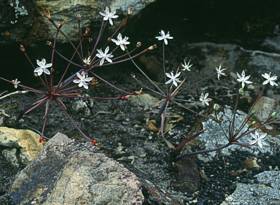
S. leipoldtii (L.Bolus) Snijman
Plants up to 150 mm high; bulb whitish inside. Leaves 2(3), dry at flowering, broadly oval to strap-shaped, 17 - 35 mm wide, smooth with a long, soft, dense fringe. Flowers 8 - 15, on long spreading pedicels, star-shaped, 10 - 20 mm across, white with green or pink midribs, scentless, stamens slightly shorter than the tepals, the filaments bulbous at the base, attached to the swollen style base, style evenly enlarged in the basal third. Flowering time: March to April. Sandstone rock ledges in loamy soils. Lambert's Bay to Olifants River Valley, Western Cape.
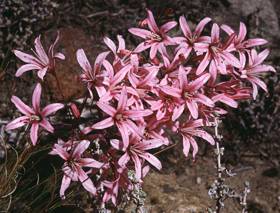
S. salteri W.F.Barker
Striking plants, up to 250 mm high; bulb whitish inside. Leaves 2(3), dry at flowering, pressed to the ground, strap-shaped to elliptic, 13-28 mm wide, dark green above, smooth but minutely fringed. Flowers 5-14, spreading, widely funnel-shaped, 15-29 mm long, glistening pink with reddish pink central bands, scentless, stamens equalling or longer than the tepals, fused to the style base for up to 3.5 mm, style stout and 3-angled towards the base. Flowering time: May. Sandstone rock crevices. Nardouw to Pakhuis Mountains and Olifants River Valley, Western Cape.

S. unguiculata (W.F.Barker) Snijman
Plants up to 300 mm high; bulb whitish inside. Leaves 2(3), usually dry at flowering, sub-erect to recurved, elliptic to lanceolate, (15 - )30 - 600 mm wide, abruptly narrowed at the base, light green, thin-textured, the margins sometimes undulate. Flowers 7 - 24, spreading on long pedicels, shallowly cup-shaped, 15 - 20 mm across, glistening white with red midribs, scented of spice, clawed at the base forming conspicuous windows between adjacent tepals, the edges more or less folded towards the apex, stamens equaling the tepals, slightly bulbous at the base, attached to the style base, style expanding evenly to a broad base. Flowering time: May. Loamy and stony soils. Botterkloof Valley, Northern Cape.
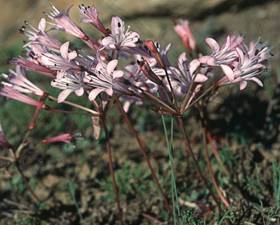
S. watermeyeri L.Bolus
Plants up to 150 mm high; bulbs whitish inside. Leaves 2(3), dry at flowering, pressed to the ground, elliptic to lanceolate, 8-17 mm wide, leathery, the upper surface dark green, the edges pustulate and sticky, often covered with sand. Flowers 4-11, suberect or curved to one side, funnel-shaped, 7-23 mm long, delicate pink, usually banded with darker pink, scentless, stamens equal to or longer than the tepals, fused to the style base for 0.5-4 mm, style stout and 3-angled towards the base. Flowering time: April to May. Shallow soil on sandstone pavements. Bokkeveld Mountains, Northern Cape
References
- Duncan, G. 2000. Grow bulbs. Kirstenbosch Gardening Series. National Botanical Institute, Cape Town.
- Du Plessis, N.M. & Duncan, G.D. 1989. Bulbous plants of southern Africa. Tafelberg, Cape Town.
- Leistner, O.A. (ed.). 2000. Seeds plants of southern Africa : families and genera. Strelitzia 10. National Botanical Institute, Pretoria.
- Loots, S. 2005. Red Data Book of Namibian plants. Southern African Botanical Diversity Network Report No. 38. SABONET, Pretoria and Windhoek.
- Manning, J., Goldblatt, P. & Snijman, D. 2002. The color encyclopedia of Cape bulbs. Timber Press, Oregon and Cambridge.
- Snijman, D.A. 1994. Systematics of Hessea, Strumaria and Carpolyza (Amaryllideae: Amaryllidaceae). Contributions from the Bolus Herbarium 16: 1-162.
- Snijman, D.A. & Victor, J. 2005 (2003-2004). Threatened Amaryllidaceae of South Africa. Herbertia 58: 91-109.
Credits
D. A. Snijman
Compton Herbarium, Kirstenbosch
September 2008
Plant Attributes:
Plant Type: Bulb
SA Distribution:
Soil type:
Flowering season:
PH:
Flower colour:
Aspect:
Gardening skill:
Special Features:
Horticultural zones






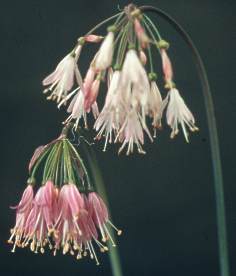
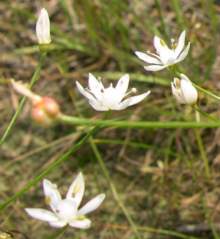
Rate this article
Article well written and informative
Rate this plant
Is this an interesting plant?
Login to add your Comment
Back to topNot registered yet? Click here to register.